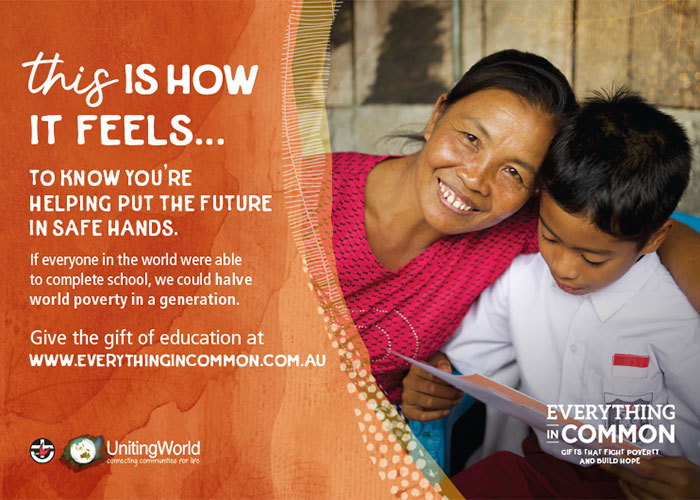Gadigal artist Konstantina (Kate Constantine) has published an extraordinary book.
Gadigal Ngura: Exploring a Gadigal Artist’s Love Affair with Her Country (2024) is filled with glorious works of art – dot paintings, explorations in colour and various media, ancient stories, contemporary truth-telling. There are also lovely photographs by the artist.
Book launch events were held last month in Newtown (Better Read Than Dead), Redfern (Cooee Art Leven) and Paddington (Berkelouw). Gadigal Elder Uncle Ray Davison gave the Welcome to Country each night.
Here Konstantina talks about her Lens Series – paintings that explore two perspectives on the same subject “where one group believed in linear time and the other had no construct of such a thing”. Her reflections on art practice evince sadness as well as deep compassion and grace.
“A lot of the time I paint duplicates, the same thing from two different viewpoints. As a fair-skinned Aboriginal woman, I walk in both worlds. I walk in a privileged white world where I’m degree qualified. I haven’t experienced the huge amount of racism that some of my brothers and sisters have experienced. And then I’m also a part of the black community. I’m a Gadigal woman, I’m Koori. My children are Aboriginal children.
“I try to find the beauty in both, but it’s also very pertinent to realise there are two very different systems at play, and to be extremely conscious of that. You think of the justice system, the education system, the health system. It’s all one-stream policy, and unfortunately this country isn’t built on a one-stream policy. It’s built from the same subject matter, human life from two very different perspectives. So, I like to paint that.
“These are exactly the same painting, even to the point where these outlines have been traced and exactly the same colours are in exactly the same order. But using a different technique to show, I suppose, a visual representation of what it’s like to look through two different eyes.
“I try to open up an intelligent conversation that sparks both curiosity and understanding.
“A Western society doesn’t value the same cultural constructs that we value. We value kinship and family above everything. We don’t value capitalism like a Western society does. If it means we have to choose between getting paid and not getting paid, most will choose not to get paid rather than compromising their morals and principles. That is often then misconstrued as laziness or sitting on welfare. But why would you want to work hard for a society and a belief system that’s not yours?
“My painting isn’t a reflection of all Aboriginal people. It’s a reflection of my identity and my journey through identity. Bringing up fair-skinned Aboriginal children so they have a better sense of self than I did growing up. I’m in my 40s. They’re little, I’ve got a 3, a 5 and a 9-year-old, and I don’t want them to turn 20 and go, ‘I don’t know where I came from and I don’t understand why it’s important’.
“There’s space for all of us but we have to create it as humans. And this is a meditative practice for me. I can paint for 10 or 12 hours straight … I go down into a deep-time space. By the time I get to the end of a series, I feel I can finally articulate it. I can speak to it in a better way than I could understand in words at the beginning. I can fully comprehend by doing. It’s the doing that allows me to process the emotion, the thinking.
“Research and art practice inform each other. Traditional cultural practice was one where you were handed your oral history from your Elders. Now I’m handed my oral history from my Elders, but also, I have this amazing available source material through archive to add more detail that has been lost since colonisation. So yeah, they feel like sound waves. Sometimes this is doing this and then the research comes in and does this, or sometimes the research is doing this, and then I’m like, I need to paint that out and work out what I think of it.
“Telling that true story of Country, from Country. Meditating on the negative things, all the joyous things that have happened in space and time – what a privilege to have time, 10 hours, to think on that.”






[…] Gadigal artist Konstantina writes: “We value kinship and family above everything” (Konstantina – interview with Kate Constantine, Andrew Collis, SSH May, 2024). […]